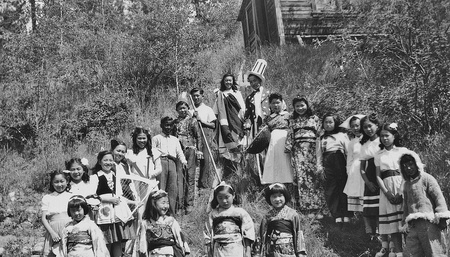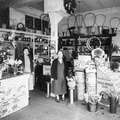In my previous article, I wrote that Greenwood became the first ‘internment camp’ in British Columbia, thanks mainly to the collaborative effort of then Mayor W.E. McArthur Sr. and Franciscan Friar Father Benedict Quigley to bring mostly Catholic Japanese Canadians and their friends and relatives to Greenwood in 1942.
The Franciscan Sisters established Sacred Heart School when the federal and provincial government was debating as to who was responsible for funding education. B.C. government was a definite ‘no’. As a result, Greenwood had an early start for the Japanese Canadian students while other camps took about nine months to set up school.
My life at Sacred Heart School began in 1950. Growing up in Greenwood, I wasn’t aware of the fact that I was in an ‘internment camp’. Everyone in school looked the same. We spoke the same ‘language’ whether it was pidgin English or Japanese. Most of the students were Japanese Canadians except for a handful of Caucasian Catholic students. SHS provided choir, sports, concerts, hiking, and of course catechism.

My school life at SHS was brief. I went from kindergarten to grade three until 1953-54. I was baptized in grade two and confirmed in grade three. I was an apprentice altar boy then. Suddenly, the school closed and we were transferred to the Greenwood Public School. Some of the United Church students were already attending that school.
I had no clue as to what impact Sacred Heart School had on Japanese Canadian students from 1942 to 1950.
As I started reviewing the Sacred Heart School 1943-54 yearbooks, I could visualize and feel the emotions of the internees coming into an almost deserted town. Therefore, I selected the following composition and speeches from students, parents, and mayor.
Each year, Mayor McArthur’s speeches changed gradually to optimism. Masao Nishimura and Kathleen Okawa’s co-composition in their Commercial class described vividly how their lives changed, and having to make adjustments in exile. For those children who had to go along with their parents’ decision to go to Japan, Shigeru Tabata’s description of postwar experiences gave a picture of despair and desperation.
After reading the students’ stories, the effect of forced relocation and to some a second time, had impacted them emotionally and mentally, but through it all, they managed to be successful in their daily lives, thanks to the Franciscan Sisters and Friars’ initiative to make life comfortable for the exiles. Greenwood gained economically with the arrival of the Japanese Canadians, and in return the church groups offered moral and spiritual support. Please read on.
* * * * *
1943-44 Yearbook
A Message from the P.T.A.:
Let me take this opportunity to recall the history of our coming to Greenwood and to the establishment of the S.H.S. that we may better able to express our whole-hearted appreciation to those who made this possible.
Those early days were gloomy ones with much mental anguish for all of us parents. I recall the many meetings and long discussions held. The government was petitioned several times in this regard. But, because of numerous insurmountable obstacles beyond our control, all of our efforts ended without success. Finally, amid great mental suffering, we parents had to give up all hope. At this crucial moment, the Society of the Atonement, after incalculable effort found a way to establish for us, not only what is now known as S.H.S., but a kindergarten as well. Ever since the establishment of this school system, the Fathers and Sisters have been most self-sacrificing in their efforts for the education of our children.
— Kichitaro Shinde, President P.T.A.
Class History:
From the residences of Steveston, Vancouver and vicinity, the ‘Japanese’ evacuated to Greenwood and to other ghost towns of the interior. We arrived here, known and unknown, and very unsettled. We were without a school. During the first summer, the Sisters conducted a summer school, and after much persevering effort, the regular school was instituted in the fall. The elementary grades opened on October 13, 1942, and since the registration was large, the double session was inaugurated. There were 30 members in our class, some friends, some complete strangers.
Graduating Class of 1944: Pauline Asano, Yosh Aura, Anna Fujisawa, Anthony Fukumura, Angela Ichikawa, Chieko Ikeda, Eiichi Imai, Ichiye Isomura, Paul Nakamachi, James Nasu, George Nose, Satoko Shigematsu, Tosh Shigematsu, George Shinde, Kimi Sokugawa, Irene Uegama, Hiko Wakabayashi and Fumiko Yamamoto.
The Evacuees’ Home in Greenwood:
Two years ago on April 26th, the evacuation to Greenwood began. The town was practically deserted except for a few carpenters who were sent here in attempt to get the place in readiness for the new arrivals. They found the buildings badly in need of repair. Greenwood was once a prosperous mining town.
At the coming of the first group of Japanese evacuees, one could hear the noise of hammer and saw all over the vicinity. The different floors of these buildings had to be divided into cubicles to house the many families that were coming from the coast. While the men were busy, thus the women went to work with pails, scrubbing brush and mop, to clean out the rubbles and wash the windows.
The sole furniture was a wooden double-decked bed....nothing else. Cleanliness means everything to our Japanese families; therefore the baths and washrooms were among the first problems that had to be solved. Then came the question of providing cooking and eating places for them.
The entire family was given but one room which was to serve all purposes of family life...some were too small, some with many windows, some with none. The woodshed was set up in the rear to hold the necessary firewood and almost immediately clothes line could be seen stretching forth in every direction from the different floors.
Today, an average evacuees’ room consists of wooden beds, a handmade table, benches and closets. A large room is set aside for the community kitchen, work tables and two sinks. On each floor is a washroom with a hot and cold water taps. There is a public bath for the benefit of all.
So, while our homes are crowded and we are living in quarters much smaller than those we formerly occupied on the coast, we are sheltered and cared for, and during the past two years many changes have been made to make us as comfortable as possible and we realize full well that we have much cause for gratitude. We shall not soon forget the hardships of this exile, nor the welcome and cooperation extended to us by the Mayor. The residents of Greenwood, too, have done much to bring peace and contentment to our families, and from the beginning we were with friends, the Society of the Atonement. We knew that, though we were homeless, we were not friendless, and only an exile knows what that means.
Health Facilities:
The health program is under the capable direction of Dr. Burnett, M.D. and staff consisting of Mrs. Rendell, R.N., Miss Higashi and five nurses’ aides and a cook.
Greenwood Hospital has 15 beds for adults and one for a child of 7 and four cribs. For surgical case, patient is sent to Grand Forks Hospital.
Soon after the arrival here in June, 1942, the Commission took preliminary measures to prevent communicable diseases. Approximately, 500 children received inoculation to prevent scarlet fever and whooping cough. In the fall of 1943, further inoculation was administered for small pox and diphtheria by Dr. Burnett, Mrs. Rendell, Dorothy Nakamachi, and Hatchi Higashi. Isolation ward was located in the south end of town in the summer of 1942.
On the whole, Greenwood’s evacuees have been well taken care for in matter of health. A census of Japanese numbers at about 1200, and up to the middle of May, the number of births recorded was 73, while the Angel of Death was visited the total of 12 persons.
— Masao Nishimura, Commercial III
Kathleen Okawa, Commercial II
Part 2 >>
© 2021 Chuck Tasaka






